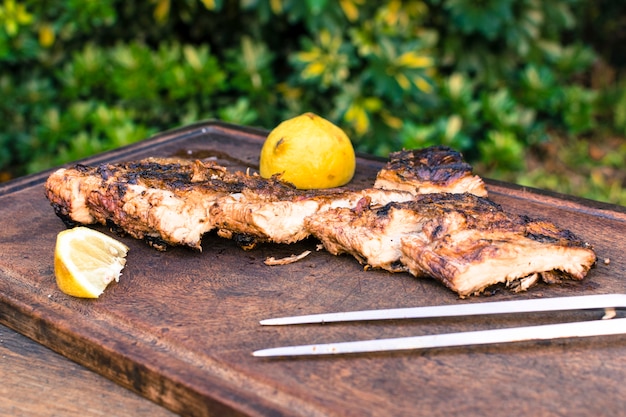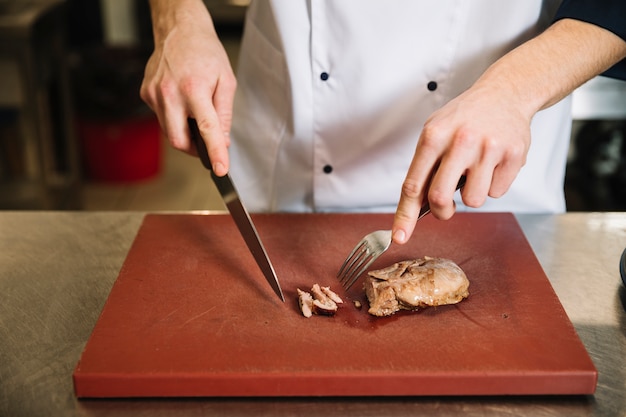There's something truly special about a perfectly cooked filet mignon. It's a cut of meat that exudes luxury and indulgence, making it ideal for special occasions or simply a weeknight treat that feels a bit more decadent. For years, I've been obsessed with perfecting my grilling skills, and filet mignon has always been my ultimate challenge. From mastering the sear to achieving that coveted medium-rare doneness, I've learned a thing or two about bringing out the best in this magnificent cut of beef. And believe me, with the right approach, anyone can grill a filet mignon like a pro. So, fire up your grill, grab a cold beverage, and let's dive into the ultimate guide to grilling filet mignon to perfection!
(Part 1) Choosing the Right Filet Mignon

The journey to a delectable grilled filet begins with selecting the perfect piece of meat. It's not just about picking the first one you see at the butcher counter; there are a few key factors to consider to ensure you're working with a filet that will deliver a juicy, flavourful, and tender result.
The Importance of Marbling
The first thing to look for is marbling. That's the intramuscular fat that runs throughout the meat. It's crucial for flavour and tenderness because it renders during cooking, creating a natural sauce that melts into the filet, making it succulent and mouthwatering. You can often find filet mignon graded based on marbling, with Prime being the highest grade and typically the most marbled. If you can't find Prime, Choice is a great alternative. However, I would avoid Select, as it’s generally less marbled, and that can lead to a drier, less tender filet.
Matching Size to Your Needs
The size of the filet matters too. For a solo grilling session, I typically go for a 6-8 ounce filet. It's just the right size for a satisfying meal without feeling too heavy. For a crowd, consider a 10-12 ounce filet, or even larger if you're feeling ambitious. Just remember that larger filets take longer to cook, so plan accordingly.
Don't Hesitate to Ask for Help
If you're unsure about the quality of the meat, don't hesitate to ask your butcher for advice. They are experts in their craft and can steer you towards the best filet for your needs. I remember one time, I was looking for a special filet for a celebratory dinner, and the butcher recommended a cut that had been aged for 21 days. It was truly a revelation, the flavour was simply divine!
(Part 2) Prepping the Filet for Success

Now that you have your chosen filet, it's time to prep it for grilling. This is where a little attention to detail can make a world of difference in the final product.
Patting It Dry is Crucial
Start by patting the filet dry with paper towels. This might seem like a simple step, but it's essential for achieving a beautiful sear. Moisture on the surface of the meat can hinder browning, preventing that crispy crust that seals in the juices and adds so much flavour.
The Right Seasoning Makes All the Difference
Next, it's time to season. I'm a big believer in keeping it simple with salt and freshly ground black pepper. The flavour of the filet itself should be the star of the show. However, feel free to experiment with other seasonings like garlic powder, onion powder, or your favourite herbs. But remember, less is often more.
Letting It Rest: The Key to Even Cooking
Now comes a crucial step: letting the filet rest at room temperature for about 30 minutes before grilling. This allows the meat to come to room temperature, which helps it cook more evenly. Imagine it like this: if you put a cold piece of meat directly on the hot grill, the outside will cook much faster than the inside, leading to uneven cooking and potentially overcooked meat on the outside while the centre remains raw. Nobody wants that!
(Part 3) Grilling Time: The Art of the Sear

Now it's time for the main event - grilling! This is where you can truly showcase your grilling skills and bring out the best in your filet.
Hot is the Way to Go
The key to a perfect sear is a scorching hot grill. Aim for a temperature of around 500°F (260°C). That intense heat creates a beautiful crust almost instantly, searing in the juices and adding incredible flavour.
Cleanliness is Essential for Great Grilling
Before you place the filet on the grill, make sure to clean the grates with a grill brush. You want a clean surface for a beautiful sear and to prevent sticking.
The Technique of the Perfect Sear
Once your grill is blazing hot, place the filet on the grate and let it sear for about 2-3 minutes per side. You'll hear that satisfying sizzle as the fat renders and see those beautiful grill marks develop. Don't be tempted to move it too much; patience is key here! The idea is to create a nice crust on each side before moving on to the next stage of cooking.
(Part 4) Mastering the Temperature Game
Now comes the art of achieving the perfect level of doneness. This is where a meat thermometer becomes your best friend.
The Importance of a Meat Thermometer
The internal temperature of the filet is the most reliable indicator of its doneness. A meat thermometer is an indispensable tool for ensuring that your filet is cooked to your liking. Over the years, I've learned that a digital thermometer is the way to go. It's quick, accurate, and eliminates any guesswork.
Target Temperatures for Different Doneness Levels
Here's a table outlining the target internal temperatures for various levels of doneness:
| Doneness | Temperature (°F) | Temperature (°C) |
|---|---|---|
| Rare | 125-130 | 52-54 |
| Medium-Rare | 130-135 | 54-57 |
| Medium | 140-145 | 60-63 |
| Medium-Well | 150-155 | 65-68 |
| Well-Done | 160 | 71 |
Using Your Thermometer Correctly
To get an accurate reading, insert the thermometer into the thickest part of the filet, avoiding contact with the grill grates, which can lead to a false reading.
(Part 5) The Art of Resting: Releasing the Flavour
Once your filet reaches the desired internal temperature, take it off the grill and let it rest for about 10 minutes. Resting is crucial for a truly amazing filet mignon. It allows the juices to redistribute throughout the meat, resulting in a more tender and flavourful steak.
The Right Resting Technique
Place the filet on a cutting board and cover it loosely with foil. This helps the meat stay warm and prevents it from drying out. For an extra touch of flavour, you can add a few sprigs of rosemary or thyme inside the foil. The aroma will infuse the filet while it rests, adding another layer of deliciousness.
(Part 6) Slicing and Serving with Finesse
After the resting period, it's time to slice and serve your masterpiece. Here are a few tips to make it a truly impressive presentation.
The Importance of Slicing Against the Grain
Use a sharp knife to slice the filet against the grain. This technique helps break down the muscle fibres, making it easier to chew and enhancing the tenderness. Slicing the filet into thin pieces allows everyone to enjoy a nice portion of that delectable meat.
Presentation Makes a Difference
When plating the filet, take a moment to consider the presentation. I like to arrange the slices on a bed of fresh arugula, a simple salad with a light vinaigrette, or a bed of creamy mashed potatoes. You can also add a dollop of creamy horseradish sauce, a sprinkle of fresh herbs, or a few slices of roasted vegetables. Let your creativity shine!
Choosing the Right Sides
No filet mignon is complete without some delicious sides. My go-to sides are grilled asparagus, roasted potatoes, or a creamy risotto. But feel free to explore other options like a simple green salad, a light pasta dish, or sautéed mushrooms. The key is to choose sides that complement the flavour of the filet without overpowering it.
(Part 7) Mastering Different Doneness Levels
One of the great things about filet mignon is its versatility. You can cook it to your preferred level of doneness, from a rare and juicy steak to a well-done, more cooked steak. Each level offers a unique flavour and texture. Here's what you need to know about achieving different doneness levels:
Rare: Tender and Juicy
A rare filet mignon is tender and juicy, with a soft, red centre. It's cooked for a shorter time, ensuring the centre stays red. However, be cautious with this doneness if you’re sensitive to undercooked meat.
Medium-Rare: The Classic Choice
This is my personal favourite. A medium-rare filet is cooked to a beautiful pink centre, with a slightly firmer texture. The meat is tender and juicy, and it’s the best for showcasing the true flavour of the filet.
Medium: A More Cooked Option
A medium filet is cooked to a brown centre with a hint of pink. It's a good option if you want a slightly more cooked filet, but it will still be tender and juicy.
Medium-Well: Firmer Texture
A medium-well filet is cooked to a brown centre with very little pink. It's a more cooked option, perfect for those who prefer a firmer texture.
Well-Done: Most Cooked Option
A well-done filet is cooked to a solid brown colour throughout. It's the most cooked option, best for those who prefer a firmer texture and a well-done steak. However, it might be a bit drier than the other doneness options.
(Part 8) My Top Tips for Grilling Success
Over the years of grilling filet mignon, I've learned a few tricks that have helped me achieve the perfect steak time and time again. Here are my top tips to help you grill like a pro:
- Don't overcrowd the grill: Give your filets space on the grill so they can cook evenly. A crowded grill will make it difficult to achieve a beautiful sear and the meat may not cook evenly.
- Use a grill thermometer: This is crucial for ensuring that your filet is cooked to your desired doneness. It eliminates guesswork and allows you to cook with confidence.
- Don't cut into the filet to check for doneness: This will cause the juices to escape, leaving you with a drier steak. Stick to using the meat thermometer for the most accurate results.
- Use a meat mallet to tenderize the filet: This is especially helpful for larger filets. It helps break down the muscle fibres, making the meat even more tender and easier to chew.
- Don't be afraid to experiment: Try different seasonings, marinades, and sauces. There's no right or wrong way to grill filet mignon. Have fun with it and explore new flavours!
(Part 9) FAQs: Common Grilling Questions Answered
Here are some frequently asked questions about grilling filet mignon, with answers to help you avoid common pitfalls and achieve grilling mastery.
1. Can I use a gas grill instead of a charcoal grill?
Absolutely! You can use a gas grill to cook filet mignon. Just make sure to preheat the grill to high heat and use the same techniques as you would with a charcoal grill. You want that nice sear, and a gas grill can achieve that.
2. How do I know if my grill is hot enough?
The best way to tell if your grill is hot enough is by holding your hand about 6 inches above the grill grate. If you can’t hold your hand there for more than 3-4 seconds, the grill is hot enough for grilling your filet.
3. What should I do if my filet sticks to the grill?
The best way to prevent sticking is to clean the grates before grilling. If your filet does stick, try using a spatula to carefully loosen it. If that doesn't work, try using a metal grill scraper to clean the grill grate and try again.
4. Can I grill filet mignon ahead of time?
You can grill filet mignon ahead of time, but it's best to serve it immediately after it's cooked. If you must grill it ahead of time, let it cool completely and then store it in the refrigerator for up to 2 days. When you’re ready to eat, reheat it in a preheated oven at 350°F (175°C) for about 10 minutes.
5. What if I overcook my filet mignon?
It happens to the best of us! If you overcook your filet, it will be drier and tougher than it should be. Unfortunately, there's no way to undo overcooking. But you can try to salvage the situation by slicing it thinly and adding a sauce to compensate for the dryness.
And there you have it, my fellow grilling enthusiasts! Armed with this guide, you're well on your way to mastering the art of grilling the most perfect filet mignon you've ever tasted. Enjoy your culinary triumph!
Everyone is watching

Perfect Rice Every Time: The Ultimate Guide to Cooking Rice
Cooking TipsAs a self-proclaimed foodie, I've always been a bit obsessed with rice. It's the foundation of countless cuisi...

Prime Rib Roast Cooking Time Chart: Per Pound Guide
Cooking TipsPrime rib roast. Just the name conjures images of lavish dinners, crackling fires, and hearty laughter. It’s ...

The Ultimate Guide to Cooking Asparagus: Tips, Techniques, and Recipes
Cooking TipsAsparagus. The mere mention of this spring delicacy conjures up images of vibrant green spears, crisp and burs...

Ultimate Guide to Cooking the Perfect Thanksgiving Turkey
Cooking TipsThanksgiving. Just the word conjures up images of overflowing tables laden with delicious food, the scent of r...

How Long to Bake Potatoes in the Oven (Perfect Every Time)
Cooking TipsBaked potatoes are a staple in my kitchen. They're incredibly versatile, delicious, and surprisingly easy to m...
